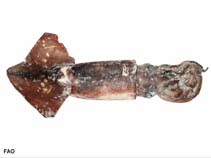Advertisement
Dosidicus gigas (D'Orbigny, 1835)
Jumbo flying squid| Native range | All suitable habitat | Point map | Year 2050 |

|
| This map was computer-generated and has not yet been reviewed. |
| Dosidicus gigas AquaMaps Data sources: GBIF OBIS |
United States (contiguous states) country information
Common names:
[No common name]
Occurrence: native
Salinity: marine
Abundance: | Ref:
Importance: | Ref:
Aquaculture: never/rarely | Ref:
Regulations: no regulations | Ref:
Uses: no uses
Comments: Known from western United States to Mexico (Ref. 1667).
National Checklist:
Country Information: https://www.cia.gov/library/publications/resources/the-world-factbook/geos/us.html
National Fisheries Authority: http://www.nmfs.gov
Occurrences: Occurrences Point map
Main Ref: Turgeon, D.D., J.F. Quinn Jr., A.E. Bogan, E.V. Coan, F.G. Hochberg, W.G. Lyons, P.M. Mikkelsen, R.J. Neves, C.F.E. Roper, G. Rosenberg, B. Roth, A. Scheltema, F.G. Thompson, M. Vecchione and J.D. Willams, 1998
National Database:
Occurrence: native
Salinity: marine
Abundance: | Ref:
Importance: | Ref:
Aquaculture: never/rarely | Ref:
Regulations: no regulations | Ref:
Uses: no uses
Comments: Known from western United States to Mexico (Ref. 1667).
National Checklist:
Country Information: https://www.cia.gov/library/publications/resources/the-world-factbook/geos/us.html
National Fisheries Authority: http://www.nmfs.gov
Occurrences: Occurrences Point map
Main Ref: Turgeon, D.D., J.F. Quinn Jr., A.E. Bogan, E.V. Coan, F.G. Hochberg, W.G. Lyons, P.M. Mikkelsen, R.J. Neves, C.F.E. Roper, G. Rosenberg, B. Roth, A. Scheltema, F.G. Thompson, M. Vecchione and J.D. Willams, 1998
National Database:
Common names from other countries
Classification / Names Tên thường gặp | Các synonym ( Các tên trùng) | Catalog of Fishes (gen., sp.) | ITIS | CoL | WoRMS
Environment: milieu / climate zone / depth range / distribution range Sinh thái học
Tầng nổi; Mức độ sâu 0 - 1200 m (Tài liệu tham khảo 1982). Tropical; 4°C - 32°C (Tài liệu tham khảo 1982), preferred 26°C (Tài liệu tham khảo 107945); 60°N - 53°S, 169°W - 70°W
Distribution Các nước | Các khu vực của FAO | Các hệ sinh thái | Những lần xuất hiện | Những chỉ dẫn
Eastern Pacific. From south of Bering Strait to Gulf of Alaska, east to Gulf of California and south to Chile. Tropical to boreal.
Length at first maturity / Bộ gần gũi / Weight / Age
Maturity: Lm 29.7 range ? - ? cm Max length : 400 cm TL con đực/không giới tính; (Tài liệu tham khảo 275); common length : 80.0 cm TL con đực/không giới tính; (Tài liệu tham khảo 275); Khối lượng cực đại được công bố: 3.0 kg (Tài liệu tham khảo 275)
Common total length: 50 to 80 cm. Caught by jigs (Ref. 275). Maximum total length is 4 m. Common length is about 50 to 80cm (Ref. 3722). Inhabits offshore areas of continental shelves from surface to depths of at least 1200 m. Found over the shelves and near shores during feeding. Adults undergo diel vertical migrations with a night lift to the 0-200 m water layer, going down at daytime to depths of 800-1,000 m and deeper (Ref. 2130). Upper temperature limits range from 30 to 32°C in equatorial areas, while deeper water temperature limits are not less than 4 to 4.5°C. Active predator, feeds actively at dusk and dawn. Commonly feeds on copepods, hyperiid amphipods, euphausiids, pelagic shrimps and red crabs (Pleuroncodes planipes), heteropod mollusks, squid, octopods and various fish. Exhibits cannibalism, but only on juvenile squids (Ref. 1982).
Life cycle and mating behavior Chín muồi sinh dục | Sự tái sinh sản | Đẻ trứng | Eggs | Sự sinh sản | Larvae
Members of the class Cephalopoda are gonochoric. Male and female adults usually die shortly after spawning and brooding, respectively. Mating behavior: Males perform various displays to attract potential females for copulation. During copulation, male grasp the female and inserts the hectocotylus into the female's mantle cavity where fertilization usually occurs. Life cycle: Embryos hatch into planktonic stage and live for some time before they grow larger and take up a benthic existence as adults.
Main reference
Các tài liệu tham khảo | Người điều phối | Người cộng tác
Roper, C.F.E., M.J. Sweeney and C.E. Nauen. 1984. (Tài liệu tham khảo 275)
IUCN Red List Status
(Tài liệu tham khảo 130435: Version 2024-2)
Data deficient (DD) ; Date assessed: 05 May 2010
CITES status (Tài liệu tham khảo 108899)
Not Evaluated
CMS (Tài liệu tham khảo 116361)
Not Evaluated
Human uses
Các nghề cá: Tính thương mại
FAO - Các nghề cá: landings, species profile | FishSource | Biển chung quanh ta
Các công cụ
Thêm thông tin
Các nước
Các khu vực của FAO
Các hệ sinh thái
Những lần xuất hiện
Những chỉ dẫn
Stocks
Sinh thái học
Thành phần thức ăn
Các loại thức ăn
Các khu vực của FAO
Các hệ sinh thái
Những lần xuất hiện
Những chỉ dẫn
Stocks
Sinh thái học
Thành phần thức ăn
Các loại thức ăn
Tên thường gặp
Các synonym ( Các tên trùng)
Các động vật ăn mồi
Sự tái sinh sản
Chín muồi sinh dục
Đẻ trứng
Sự sinh sản
Eggs
Egg development
Các synonym ( Các tên trùng)
Các động vật ăn mồi
Sự tái sinh sản
Chín muồi sinh dục
Đẻ trứng
Sự sinh sản
Eggs
Egg development
Các nguồn internet
BHL | BOLD Systems | CISTI | DiscoverLife | FAO(Các nghề cá: species profile; publication : search) | GenBank (genome, nucleotide) | GloBI | Gomexsi | Google Books | Google Scholar | Google | PubMed | Cây Đời sống | Wikipedia (Go, tìm) | Tạp chí Zoological Record
Estimates based on models
Preferred temperature
(Ref. 115969): 7.8 - 13.8, mean 10.8 (based on 88 cells).
Thích nghi nhanh
(Tài liệu tham khảo 69278)
Chiêù cao, thời gian nhân đôi của chủng quần tối thiểu là dưới 15 tháng (K=0.17-1.2; tm=0.53).
Prior r = 1.19, 95% CL = 0.79 - 1.79, Based on 2 data-limited stock assessments.




